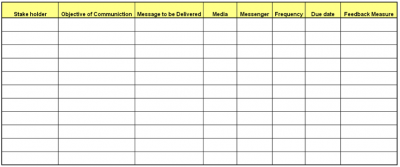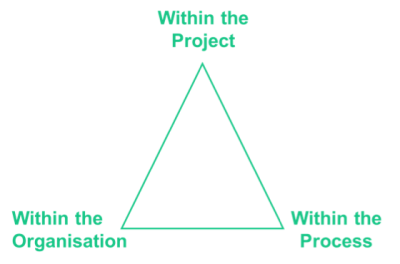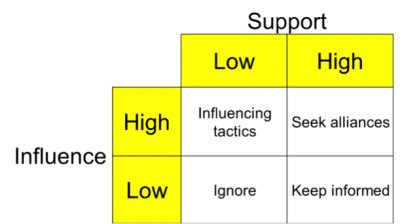In the previous article (5 Key Elements of Managing Change in Improvement Projects) we advised improvement project leaders to have a structured approach to five key elements when managing change in projects:
- Focus on the “A” side of the Q x A = E equation
- Establish clear goals and objectives
- Provide leadership
- Manage resistance
- Communicate, communicate, communicate
Focusing on the A side of the Q x A = E equation means improvement project leaders should spend time on ensuring cultural acceptance and not just time on technical tools and data. Master Black Belts should spend 50% of their time on the A side of the equation. Probably Black Belts should spend at least 30% of their time on A, and Green Belts 20%. This will vary depending on the challenges faced of course but it gives an idea of how significant a commitment is required.
Establishing clear goals and targets will flow from a correct project charter, with the problem statement clarifying why this project is being tackled and what pain the organisation is feeling. The project objective should be derived from to the problem statement, and reflect the improvement sought through the project. A useful framework often used to help set objectives is SMART. SMART helps to clearly define the objective by checking it is:
- Specific: to the problem/situation
- Measurable: and confirmable
- Agreed: by all parties involved
- Realistic: a stretch goal but not too far out of reach
- Time-bound: specified when it will be achieved by
This activity is always best to do in conjunction with the team, although there may be ideas of what needs to be achieved beforehand. Agreeing to it with the team will encourage ownership and buy-in from them.
Providing leadership is also an important aspect of managing any improvement project. The original model of the Black Belt was someone that could develop further within the organisation, someone who would be able to take on a more senior position and provide leadership. So, demonstrating leadership qualities in the project is expected.
In their book first published in 1987, The Leadership Challenge, Jim Kouzes and Barry Posner describe a model for leadership consisting of five key elements. The Leadership Challenge uses case studies to examine “The Five Practices of Exemplary Leadership”. Their first surveys for the five practices started in 1983, by asking people “What do you do as a leader when you’re performing at your personal best?” Over 30 years, Kouzes and Posner did thousands of interviews and collected over 75,000 written responses. They identified five common concepts in their survey, which are: Model the Way, Inspire a Shared Vision, Challenge the Process, Enable Others to Act and Encourage the Heart.
Model the Way
Leaders establish principles concerning the way people (constituents, peers, colleagues, and customers alike) should be treated and the way goals should be pursued. They create standards of excellence and then set an example for others to follow. Because the prospect of complex change can overwhelm people and stifle action, they set interim goals so that people can achieve small wins as they work toward larger objectives. They unravel bureaucracy when it impedes action; they put up signposts when people are unsure of where to go or how to get there; and they create opportunities for victory.
Inspire a Shared Vision
Leaders passionately believe that they can make a difference. They envision the future, creating an ideal and unique image of what the organization can become. Through their magnetism and quiet persuasion, leaders enlist others in their dreams. They breathe life into their visions and get people to see exciting possibilities for the future.
Challenge the Process
Leaders search for opportunities to change the status quo. They look for innovative ways to improve the organization. In doing so, they experiment and take risks. And because leaders know that risk taking involves mistakes and failures, they accept the inevitable disappointments as learning opportunities.
Enable Others to Act
Leaders foster collaboration and build spirited teams. They actively involve others. Leaders understand that mutual respect is what sustains extraordinary efforts; they strive to create an atmosphere of trust and human dignity. They strengthen others, making each person feel capable and powerful.
Encourage the Heart
Accomplishing extraordinary things in organizations is hard work. To keep hope and determination alive, leaders recognize contributions that individuals make. In every winning team, the members need to share in the rewards of their efforts, so leaders celebrate accomplishments. They make people feel like heroes.
Extracted from The Leadership challenge, Jim Kouzes and Barry Posner
Identifying and managing resistance is an essential task of any leader, and Lean Six Sigma promotes a structured approach to this which can be summarised in 5 steps:
- Identify project stakeholders
- Define current level of support & influence
- Determine desired level of support & influence
- Define influencing tactics
- Create action and communications plans
1. Identify project stakeholders
The first step in planning influencing tactics and communications is to understand who needs to be communicated to and influenced. This involves identifying who the stakeholders are, and the triangle here shows three key areas to look: Within the project itself consider people such as the champion, the project team and process owner. Technical experts such as IT support or maintenance support staff may also be involved. The people listed will depend on nature of the project of course.
Within the process consider the people that actually operate the process day-to-day. It is very often the case that these people will be the ones that will be involved in data collection, and implementing improvements, so their support will probably be very useful. Consider an improvement project looking at improving the way invoices are processed in an accounting function, the support of the accounts clerks will be helpful when implementing process changes.
Within the organisation consider those that are not directly involved in the process or project, but may also have a stake in the project, for example a project to improve customer service or on-time delivery may not involve sales, but sales managers and directors have a very keen interest in improving these areas as it makes it easier to retain existing customers and attract new ones.
Lastly don’t forget the wider environment, customers and suppliers may also have a stake in the project outcome, for example suppliers if any changes may affect their levels of supply, customers if service will be improved, or if the interface with them could change.
2. Define current level of support & influence
Once the stakeholders are listed, consider two aspects: their level of support for the project, and their level of influence.
Key questions here are when push comes to shove, will this person support me and what we need to do, or not? The level of support for the project may vary from enthusiastic through to uncooperative. Remember that resistance is not always shown as overt resistance, and it may be covert in nature.
The level of influence may range from critical, through to inconsequential, in other words ranging from it makes a massive difference to it makes no difference at all. A key question to ask is if I wanted to, could I push through a change to this process without the support of this person?
3. Determine desired level of support & influence
Once stakeholders are listed and their level of support and influence has been determined, they can be mapped on a matrix as shown below.
If post-it notes or similar are used to record each stakeholder, then the post it notes can be positioned onto the grid and easily moved if necessary. In simple terms, there are 4 segments: from high influence high support to low influence low support. In reality, there will be a continuum and you may decide level of support is medium rather than low or high! Be careful not to overcomplicate things though.
Different approaches are taken for each of the four quadrants. Low support low influence stakeholders can be “ignored”, this means do not waste too much time on this group. They can be included in general communications but they are not the area where resource is best used. High support low influence stakeholders should be kept informed of progress to keep them supportive, but once again don’t expend too much resource on this group. The stakeholders in high support, high influence are those with whom alliances should be sought, try and keep good contact with these people, and make sure they are communicated to regularly. These people can be extremely useful when you need support during the project.
The last area, high influence, low support is the area where most time is needed. Their level of support needs to change so that they become more supportive. This is likely to require more than just standard communication, it will require thought as to how their level of support can be changed, and in the next section we will discuss some of the tactics that can be used to achieve this.
4. Define influencing tactics
We can group influencing tactics into two broad areas; business level and individual. Business level influencing is about thinking through what the business benefits are from doing the project in question, individual influencing is about thinking through why a specific individual might want this project done.
At a business level, think through the business & customer case. Consider the project from two dimensions, internally within the business, and externally from a customer perspective. Ask and try and answer the following questions:
- Why is the project worth doing?
- Why should it be done now
- What might the consequences of not doing it be?
You should also consider how the project fits with the business goals and targets, and what other activities have higher or equal priority.
Consider the example of a project to improve service delivery at a book store. The book store is losing money because customers are moving away to other suppliers.
The project is important to the business because it will stop revenue decreasing, if is not done now then the company will continue to lose money and ultimately may be in danger of going out of business. From a customer perspective, the better service will provide a more pleasant experience and they will be happier. The sooner the project is done the faster the customers will benefit, and if it’s not done they will continue to be dissatisfied.
The bookstore is doing plenty of other things, introducing a new warehouse, new IT systems planned, sales office upgrade, but tell me are any of these things going to ultimately be useful if the project to improve service is not done? Surely the project to improve service is imperative, whilst the others are nice to haves once service has been enhanced and the business is no longer losing money with its customers dissatisfied?
Individual tactics involve thinking about the individual or possibly group of stakeholders and asking WIIFM, which stands for “What’s in it for me”. Most people when asked to do something will have this thought, to a greater or lesser extent. If the project team can find examples of things that answer the question “What’s in it for me” then they will have more chance of influencing the stakeholder.
Consider the example of a sales manager in the previous illustration, she wants the office upgrade because it will help the sales environment and whilst we are not arguing that this should not be done, let’s think through what might be in it for our sales manager if we were to complete our service enhancement project. No doubt once you think about it there are several potential benefits for her, better service means easier sales, easier sales means more satisfied sales staff, sales values will rise, our sales manager will have an easier time getting budget for an even better office upgrade and may even be up for promotion with all those extra sales!
NIH stands for Not Invented Here, and we all can think of people that won’t accept an idea purely because it has not come from them. The best way to deal with this is to try and get the other person to think that the idea came from them in the first place! Place articles on their desk (or get a colleague to do so) about the type of project being tackled and how it has improved things in other companies, send emails with references to websites discussing the kind of improvements required, get colleagues talking about improvement in service.
With a bit of luck, our sales manager will suggest the very thing we want to do anyway, believing it is their idea!
The final influencing tactic is called Data, Demonstrate, Demand, or the 3 “D”’s.
This tool is intended to be used in sequence:
- Data – use data to show how the improvement proposed will work.
- Demonstrate – how this approach has worked elsewhere, for example for a competitor, elsewhere in the supply chain or in another segment.
- Demand – If all else fails then get someone in authority to exert some influence and persuade the stakeholder to support you!
These tools are magic, in that they won’t always ensure that you get the support you need, but using them and learning to use them well will help the maximum chance of success.
5. Create action and communications plans
Once tactics have been established where they are required for individual stakeholders communication plans can be put together for the project as a whole. This communication plan should address the stakeholder/stakeholder group, objective of the communication, frequency, due date, and any feedback measures to make sure that the communication activity is achieving the desired results.
The communication should also consider the MESSENGER, which does not have to be the project leader, it can be anyone that the stakeholder is most likely to take note of, someone they report to or respect. The MEDIUM relates to the way in which the message is delivered, for example face –to-face, telephone, phone, email and so on. MESSAGE relates to the message that will be communicated, for example progress update, issues raised, and concerns. Make sure the message is honest, simple and clear and relevant to the stakeholders.
Toll Gate Reviews
Part of the governance for Lean Six Sigma projects should be toll gate reviews. These should be carried out at the end of each phase of the project, and/or at preset review dates. Typical attendees include the champion; process owner; belt and project mentor if there is one.
The agenda should include a reminder of the project problem and goal statements, project timing plan, progress against the plan, any points requiring discussion and the next steps planned for the project.
If the review is to sign off the project for the next phase, then a checklist of items which should have been completed by that phase of the project can be used. Potential outcomes of such reviews include agreement to progress to the next phase, the need to go back and do more work before progressing or possibly even to postpone, cancel or reorganize the project.
Keys to Success
The final component of communication planning is to recognise that it is just that, planning. The real key to successful project communication is to actually carry out the communication plan! In summary, remember the following points and your chances of project success will be greatly enhanced.
- Always be a leader
- Build a guiding coalition of senior influencers
- Build consensus for project outcomes
- Keep key stakeholders informed of progress
- Utilise informal as well as formal communication routes
- It’s difficult to over communicate
- Always be proactive in managing resistance
- Remember Q x A = E!
This article originally appeared here.
Business & Finance Articles on Business 2 Community(72)
Report Post











